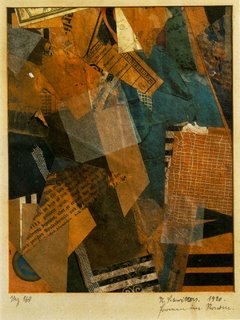main spring

 Jeremiah Donovan, Walnut Bowl Inside/Out, Earthenware Clay layered with Terrasigilatta and Raku Glazes (Multi-Fired), 12" x 14"
Jeremiah Donovan, Walnut Bowl Inside/Out, Earthenware Clay layered with Terrasigilatta and Raku Glazes (Multi-Fired), 12" x 14"A version of my review appearing in the Times, 3/19/08 (which I can't find online):
The Main Street Gallery's annual spring show covers an eclectic range of styles and mediums with an emphasis on local artists. The show has been markedly strong in recent years (particularly relative to similar efforts by other area galleries) and this year's feels particularly so.
Cornell professor Buzz Spector's Creeley's Creeleys exemplifies his recent large format Polaroid work as well as his use of books as brick-like sculptural units. The bricks here come from the collection of the late poet Robert Creeley and collectively form an oblique, associative portrait. The volumes vary richly in color, design, and typography; some include author photos. They are arranged in a roughly circular cluster of small stacks (some clearly showing different editions of the same book). The stacks zig-zag — facing in different directions — and grow taller towards the back. They sit on rough, unpainted floorboards which emphasize the picture's deep perspective. (As does the contrasting flatness of scattered volumes placed upright, more or less parallel to the picture-plane, as if in a bookstore display) The image itself is sensuous with subtle contrasting tones and artful blurring along the top and bottom edges.
Birds in Conversation, Gold, by Ithacan Kumi Korf, is another standout. The tall intaglio print belongs to a recent series in which she attempts to provide an abstract analogue for the experience of flight. Like others, this one features a flock of flatly painted, hard-edged shapes arranged against a brushy, gestural background. In Gold there are three. Moving from top to bottom, left to right and then back left: a warm grayish-blue one most resembling a bird in profile (wings closed), a burnt orange amoeba, and a red one suggesting a kite or an arrow. These are tied together by curving green line suggesting a flight line or a thread. These stick sharply out of a ground of indian yellow, printed over silver onto a thin tan-colored Japanese paper sheet.
Korf's long-standing print collaborator is Ink Shop master-printer Christa Wolf. Wolf herself is well-represented here by the monotype landscape Alegretto. The piece loosely depicts a view of the landscape surrounding her upstate NY farmhouse. The piece is arranged in vertical tiers of wave-like, gestural marks barely hinting at perspective. The bottom half is dominated by a pair of dark purple-brown tree trunks, gnarly and with bare branches leaping out sideways. The brushing reveals the white of the paper. The colors -- mostly greens with small patches of reddish brown --are faintly iridescent.
Victoria Romanoff (another well-known Ithacan), offers an engaging collage-painting, The Oysters of Le Havre. The bits that make up this "paper mosaic" fit each other snugly without overlapping. Although the scene is fragmented and filled with abstract mark-making, it is recognizable as a landscape with a shoreline. A relatively empty horizontal bar towards the top is warm gray (apparently sprayed) and indicates sky. Marks elsewhere are predominantly whitish — pink and blue — and applied via thick and thin paint and with chalk or crayon. The whole vista is surrounded by a pink painted border, relatively dark, but tied to the rest through similar marks.
The inclusion of functional pottery is a distinguishing characteristic of the Main Street's group shows; included here are the decoratively glazed vessels of Anna Velkoff Freeman — two tall cups and a wide, shallow bowl. The white on dark blue designs are stylized depictions of dangerous microbes. The inclusion of the foodborne e coli (on the bowl and one of the cups) is a cheap joke but their sinuous tendrils do form interesting patterns.
Much more interesting sculpturally are three asymmetric goblet-like bowls by the Groton native Jeremiah Donovan. They are inspired by the forms — interior and exterior — of walnuts, and their jagged inner ridges and staggered, uneven rims limit their functionality. Colors are copper brown and greenish. The outside edges (along with parts of the inside) are rough, covered in scored lines and accreted dirt clumps.
The least satisfying mode of art on display here is a figural, narrative surrealist sculpture based on an assemblage aesthetic. By far the strongest work in this vain is Gail Hoffman's Messenger, a bird-headed figurine welded together from cast bronze fragments. Included are casts from real objects, e.g. a leaf wing and a doily covering its chest. In comparison, Claire Harootunian's Angel Mine and Lead On look rather slight. Both feature tiny, minimally altered dolls sitting atop benches: clay and painted wood, respectively.
"Spring Group Exhibition" will be of greatest interest to those already familiar with the works of the artists shown. The particular style of combining well-known area artists with select (and perennial) "outsiders" is idiosyncratic to the Main Street. Visitors from past years should feel an engaging tension between the expected and the new, as different aspects of artists' work are (often slowly!) revealed.
Labels: ceramics, collage, ithaca times, painting, printmaking, sculpture






